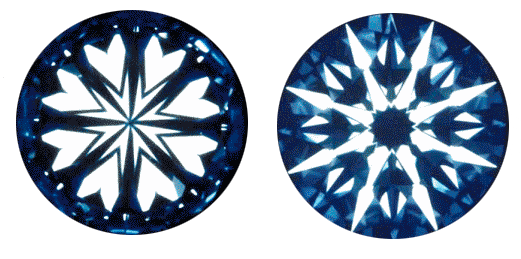Education & Guidance
Diamonds
Diamonds are amongst the rarest and most beautiful creations on earth and buying a diamond should be a memorable experience but not a daunting one.
Understanding what characteristics make up a diamond is the easy part, choosing the perfect one is up to you. There are 4 characteristics which identify a diamond, they are the 4 C’s.
Clarity
Clarity is the term used to describe the size and number of inclusions in a diamond.These inclusions are nature's finger print and make every diamond quite unique. Most are quite difficult to see with the naked eye and require magnification to become apparent. The fewer the inclusions, the rarer the stone.

Colour
Diamond colour grades start at D and continue through the alphabet. Truly colourless stones, graded D, are extremely rare and very valuable. The closer a diamond is to being colourless, the rarer and more valuable it is.

Carat
The weight of a diamond is measured in carats. One carat is divided into 100 "points" so that a diamond of 25 points is described as a quarter of a carat or 0.25 carats.

The Carat measurement of a diamond is actually a measurement of the Diamond's weight rather than its size or diameter
Cut
When a diamond is cut to ideal proportions, light is reflected from one facet to another and then dispersed through the top of the stone.
A skilful Diamond Cutter can unlock an incomparable natural beauty by accurately arranging each facet to maximise the amount of light returned to the eye of the observer.Under these ideal proportions diamonds can produce and hearts and arrows effect as seen in the below diagram.

Gemstones
Gemstones again are governed by the rules of the four C’s. Cut, Colour, Clarity and Carat. This determines the quality of the stone and its value.
Some of the most popular gemstones include:

Treated/enhanced: Many gemstones will undergo some kind of treatment between the time they are mined and the time they reach you. These treatments are carried out in order to improve the appearance of the stone (color or clarity).
Natural: The word natural is usually used to mean that the gemstone is not man made. It does not necessarily mean untreated. However it does mean the stone is as un touched as possible.
Untreated: When you see this word in a jewelry description, you can know that you’re seeing something rare (depending on the stone).
Metals
The metal types commonly used to make jewellery include gold, platinum, titanium, silver and stainless steel. Metals including rhodium and palladium are also used with jewellery.
There are two things to consider when looking at gold. First, which gold carat to choose and second, the gold color or the combination of gold colors available.
Gold
9ct gold contains 37.5% pure gold (375 parts per thousand parts).
14ct gold contains 58.5% pure gold (585 parts per thousand parts).
18ct gold contains 75% pure gold (750 parts per thousand parts).
The higher the proportion of gold used in the final metal, the more valuable and expensive the metal will be.
Gold is available in several different colors. The most popular is yellow gold, followed by white gold and rose gold.
When white gold rings are new they can be coated with another white metal called Rhodium. Rhodium is a metal very similar to platinum and rhodium shares many of the properties of platinum including its white color.
Titanium
Titanium is a natural element which has a silver-grayish-white color. Titanium is the hardest natural metal in the world. It is very strong, three times the strength of steel and much stronger than gold, silver and platinum and yet is very light weight. Pure titanium is also 100% hypo-allergenic which means that it if safe for anyone to wear as it will not react to your skin.
Platinum
Platinum is a white metal, but unlike gold it is used in jewellery in almost its pure form (approximately 95% pure). Platinum is extremely long wearing and is very white, so it does not need to be rhodium plated like white gold does.
Platinum is very dense and heavy metal, so a platinum ring will feel heavier than an 18ct gold ring.
Platinum is, however, significantly more expensive than gold. With all other things being the same, a platinum ring will be approximately twice the price of an 18ct white gold ring.
Silver
Sterling silver is a white-grey colored metal which is less expensive than gold, platinum and titanium.
Silver is a softer metal than gold, titanium and platinum and does not have hardness that the other metals do.
Silver is also more prone to oxidization, sometimes causing the silver to turn black.
Shop safely with complete protection. We support PayPal, Google Checkout and all major credit/debit cards - VISA, MasterCard, Maestro, Solo and more.

 Lifetime Warranty
Lifetime Warranty 










